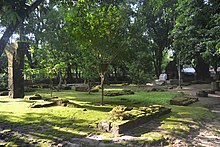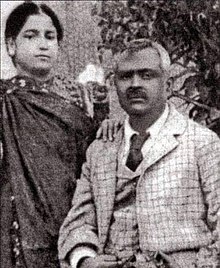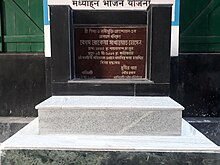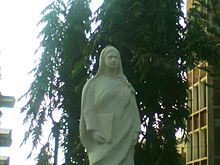Begum Rokeya
 From Wikipedia - Reading time: 13 min
From Wikipedia - Reading time: 13 min
Begum Rokeya Sakhawat Hossain | |
|---|---|
 | |
| Born | Rokeya Khatun 9 December 1880 |
| Died | 9 December 1932 (aged 52) |
| Resting place | Kolkata, West Bengal, India |
| Other names |
|
| Occupation(s) | Writer, Feminist Thinker, Educator, Activist |
| Spouse |
Khan Bahadur Sakhawat Hossain
(m. 1898; died 1909) |
| Relatives | Karimunnesa Khanam Chaudhurani (sister) Abdul Karim Ghaznavi (nephew) Abdul Halim Ghaznavi (nephew) |
Rokeya Sakhawat Hossain[a] (9 December 1880[b] – 9 December 1932), commonly known as Begum Rokeya,[c] was a prominent Bengali feminist thinker, writer, educator and political activist from British India. She is widely regarded as a pioneer of women's liberation in Bangladesh and India.
She advocated for men and women to be treated equally as rational beings, noting that the lack of education for women was responsible for their inferior economic position.[3] Her major works include Matichur (A String of Sweet Pearls, 1904 and 1922), a collection of essays in two volumes expressing her feminist thoughts; Sultana's Dream (1908), a feminist science fiction novella set in Ladyland ruled by women; Padmarag ("Essence of the Lotus", 1924) depicting the difficulties faced by Bengali wives;[5] and Abarodhbasini (The Confined Women, 1931), a spirited attack on the extreme forms of purdah that endangered women's lives and self-image.[2]
Rokeya held education to be the central precondition of women's liberation, establishing the first school aimed primarily at Muslim girls in Kolkata. She is said to have gone from house to house persuading the parents to send their girls to her school in Nisha. Until her death, she ran the school despite facing hostile criticism and social obstacles.[2][6]
In 1916, she founded the Muslim Women's Association, an organization that fought for women's education and employment.[2][7] In 1926, Rokeya presided over the Bengal Women's Education Conference convened in Kolkata, the first significant attempt to bring women together in support of women's education rights.[7] She was engaged in debates and conferences regarding the advancement of women until her death on 9 December 1932, shortly after presiding over a session during the Indian Women's Conference.[7]
Bangladesh observes Rokeya Day on 9 December every year to commemorate her works and legacy.[8] On that day, Bangladesh government also confers Begum Rokeya Padak on individual women for their exceptional achievement.[9] In 2004, Rokeya was ranked number 6 in BBC's poll of the Greatest Bengali of all time.[10][11]
Background and family
[edit]
Rokeya was born in 1880, to an aristocratic Bengali Muslim family in the village of Pairaband, Rangpur, Bengal Presidency, (erstwhile undivided Bengal) .[2] Her ancestors had migrated from Tabriz in Iran to create fortune in India and had established a zamindari in Rangpur, they had served in the military and judiciary during the Mughal regime.[12][2] Her father, Zahiruddin Muhammad Abu Ali Haidar Saber, was a zamindar and a multi-lingual intellectual.[2] He married four times; his marriage to Rahatunnessa Sabera Chaudhurani resulted in the birth of Rokeya, who had two sisters and three brothers, one of whom died in childhood. Rokeya's eldest brother Ibrahim Saber, and her immediate elder sister Karimunnesa Khanam Chaudhurani, both had a major influence on her life. Karimunnesa wanted to study Bengali, the language of the majority in Bengali people, against her family's wish who preferred to use Arabic and Persian as the media of education and communication. Ibrahim taught English and Bengali to Rokeya and Karimunnesa.[13] Karimunnesa married at the age of fourteen and later became a poetess. Both of her sons, Abdul Karim Ghaznavi and Abdul Halim Ghaznavi, became politicians and occupied ministerial portfolios under British authorities.[citation needed]
Marriage
[edit]
Rokeya married at the age of 18, in 1898 to 38-year-old Khan Bahadur Sakhawat Hossain. He was an Urdu-speaking deputy magistrate of Bhagalpur (a present-day district of Bihar state). He earned his bachelor of agriculture degree from England and was a member of Royal Agricultural Society of England. He married Rokeya after the death of his first wife. As a liberal, he encouraged Rokeya to continue learning Bengali and English. He also encouraged her to write, and on his advice, she adopted Bengali as the principal language for her literary works.[citation needed]
Rokeya wrote Sultana's Dream (1908) before her husband died in 1909. In Sultana's Dream, Rokeya wrote reversing the roles of men and women in which women were the dominant sex and the men were subordinate and confined to the mandana (the male equivalent of the zenana). She also depicts an alternative, feminist vision of science, in which inventions such as solar ovens, flying cars, and cloud condensers are used to benefit the whole of society.[14][15] It is regarded as a notable and influential satire. She wrote regularly for the Saogat, Mahammadi, Nabaprabha, Mahila, Bharatmahila, Al-Eslam, Nawroz, Mahe Nao, Bangiya Musalman Sahitya Patrika, The Mussalman, Indian Ladies Magazine and others.[2]
Five months after Rokeya's husband's death, she established a high school, naming it Sakhawat Memorial Girls' High School.[16] It started in Bhagalpur, a traditionally Urdu-speaking area, with five students. A dispute with her husband's family over property forced her to move the school in 1911 to Calcutta, a Bengali-speaking area.[16] She ran the school for 24 years.[2]
Rokeya founded the Anjuman-e-Khawateen-e-Islam (Islamic Women's Association), which was active in holding debates and conferences regarding the status of women and education. She advocated reform, particularly for women, and believed that parochialism and excessive conservatism were principally responsible for the relatively slow development of Muslims in British India. Anjuman-e-Khawateen-e-Islam organised events for social reforms based on the original teachings of Islam that, according to her, were lost. [citation needed]
Literary style
[edit]Rokeya wrote in a number of genres: short stories, poems, essays, novels and satirical writings. She developed a distinctive literary style, characterised by creativity, logic and a wry sense of humour. She started writing in the Nabanoor from about 1903, under the name of Mrs R S Hossain. However, there is an opinion that her first published writing Pipasa appeared in the Nabaprabha in 1902. Her writings called upon women to protest against injustices and break the social barriers that discriminated against them.[17]
Novels written by Begum Rokeya
[edit]Whenever any woman tries to raise her head, weapons in the form of religions or holy scriptures strike her head. … Men propagate those scriptures as God's commandments to subdue us in darkness. … Those scriptures are nothing but systems constructed by men. The words we listen from male saints would be different if they were spoken by female saints. … Religions only tighten the yoke of servitude around women and justify male domination over women.
Rokeya in 1904[18]
- Pipasha ("Thirst") (1902)
- Matichur 1st Vol. (Essays) (1904)
- Matichur 2nd Vol. (Essays) (1922)
The second volume includes stories and fairy tales:
- Saurajagat (The Solar System),
- Delicia Hatya (translation of the Murder of Delicia – Marie Corelli)
- Jnan-phal (The Fruit of Knowledge)
- Nari-Srishti (Creation of Women)
- Nurse Nelly
- Mukti-phal (The Fruit of Emancipation)
- Sultana's Dream (1905)
- Padmarag ("Essence of the Lotus") (novel) (1924)
- Abarodhbasini ("The Secluded Women") (1931)
- Boligarto (short story)
- Narir Adhikar ("The Rights of Women"), an unfinished essay for the Islamic Women's Association
- God Gives, Man Robs (1927)
- Education Ideals for the Modern Indian Girl (1931)
Death and legacy
[edit]
Rokeya died of heart problems on 9 December 1932, on her 52nd birthday.
9 December is celebrated as the Rokeya Day in Bangladesh. On 9 December 2017, Google celebrated her 137th birthday, honoring her with a Google Doodle.[19]
Rokeya's grave in Sodepur was rediscovered due to the efforts of the historian Amalendu De. It is located inside the campus of Panihati Girls' High School, Panihati, Sodepur.[20]

Rokeya is considered as the pioneer feminist of Bengal.[9][21][22] Universities, public buildings and a National Award has been named after her in Bangladesh.[23][24] She was an inspiration for many later generation female authors including Sufia Kamal, Tahmima Anam, and others.[25][26]
Eponyms
[edit]- Begum Rokeya Day, a commemoration of the birth and death anniversary of Rokeya, observed annually on 9 December in Bangladesh.[27]
- Begum Rokeya Padak, a Bangladeshi national honour conferred on individual women for their exceptional achievements.
- Begum Rokeya Memorial Center, an academic and cultural hub in Pairaband, Bangladesh.[28]
- Rokeya Shoroni, a road in Dhaka.[29]
- Begum Rokeya University, a public state university in Bangladesh.[30]
- Rokeya Hall, the largest female residential hall of the University of Dhaka. Even Khulna University of Engineering and Technology, Bangladesh Agricultural University, Rajshahi University also has a female residential hall named after Begum Rokeya.
- Sakhawat Memorial Govt. Girls' High School, kolkata, West Bengal.
- Begum Rokeya Smriti Balika Vidalaya in Saltlake, West Bengal.
Notes
[edit]- ^ Though "Rokeya Sakhawat Hossain" (a romanized form of her married name in Bengali: রোকেয়া সাখাওয়াত হোসেন") is the commonly used spelling of Rokeya's full married name, Rokeya herself is never seen to use her full married name in this English spelling. In much of her correspondence in English, she used just her initials: 'R. S. Hossein' (also used on the cover of the 1st edition of Sultana's Dream). In some other correspondences in English, she used "Rokeya Khatun", or "Khatoon". In most of her correspondence in Bengali, she used just her first name "রোকেয়া" (would be "Rokeya" if romanized).[1][2]
- ^ Though Rokeya's birthday is celebrated along with her death anniversary on 9 December, her birthday is more conjecture than a fact as it was not documented.[3][4]
- ^ The honorific "Begum" is not a part of Hossain's name; it is added as a feminine title of respect, primarily in the Indian subcontinent.[1]
References
[edit]- ^ a b "A Feminist Foremother: Critical Essays on Rokeya Sakhawat Hossain". The Daily Star. 16 September 2017. Archived from the original on 7 October 2023. Retrieved 17 December 2018.
- ^ a b c d e f g h i Akhter, Shahida (2012). "Hossain, Roquiah Sakhawat". In Islam, Sirajul; Jamal, Ahmed A. (eds.). Banglapedia: National Encyclopedia of Bangladesh (Second ed.). Asiatic Society of Bangladesh. Archived from the original on 6 August 2020. Retrieved 28 November 2015."Roquia Sakhawat Hussain (Begum Rokeya)". Londoni. Archived from the original on 26 November 2018. Retrieved 16 August 2014.
- ^ a b Azad, Humayun. "Purushtantra o Rokeyar Naribad" পুরুষতন্ত্র ও রোকেয়ার নারীবাদ [Patriarchy and Rokeya's Feminism]. Naree নারী [The Woman] (in Bengali). Dhaka: Agamee Prokashon. pp. 282–299.
- ^ Begum, Maleka (2018). Rokeya Sakhawat Hossain রোকেয়া সাখাওয়াত হোসেন (in Bengali). Dhaka: Prothoma. p. 11.
- ^ Sarkar, Siuli (2016). Gender Disparity in India: Unheard Whimpers. PHI Learning Pvt. Ltd. p. 73. ISBN 978-8120352513. Retrieved 27 November 2018.
- ^ "The enduring legacy of Begum Rokeya". The Independent. 9 December 2016. Archived from the original on 21 April 2019. Retrieved 21 April 2019.
- ^ a b c "Begum Rokeya Sakhawat Hossain". Sewall-Belmont House Museum. Sewall-Belmont House & Museum. Archived from the original on 24 June 2016. Retrieved 25 June 2016.
- ^ "Begum Rokeya Day today". The Daily Star. Archived from the original on 12 March 2018. Retrieved 25 June 2016.
- ^ a b "Begum Rokeya Day on 9 December". Dhaka Tribune. Archived from the original on 7 January 2016. Retrieved 25 June 2016.
- ^ "BBC Listeners' Poll". The Daily Star. 16 April 2004. Archived from the original on 25 December 2018. Retrieved 21 April 2019.
- ^ "Mujib, Tagore, Bose among 'greatest Bengalis of all time'". The Hindu. 17 April 2004. Archived from the original on 25 December 2018. Retrieved 21 April 2019.
- ^ Sengupta, Kaiser (5 March 2022). "'Bengali Muslim' As An Oxymoron: Crisis And Conflict Of Identities | Bengal Renaissance". Archived from the original on 11 July 2023. Retrieved 11 July 2023.
- ^ Anwar S. Dil, Afia Dil (2014). Women's Changing Position in Bangladesh: Tribute to Begum Rokeya. Intercultural Forum. pp. 10–16. ISBN 978-9842003738.
- ^ Lewton, Thomas (2019). "Feminist Visions of Science and Utopia in Rokeya Sakhawat Hossain's 'Sultana's Dream'". Lady Science. Archived from the original on 1 March 2023. Retrieved 23 August 2019.
- ^ Hossain, Rokeya Sakhawat (1905). Sultana's Dream. Madras: The Indian Ladies' Magazine. Archived from the original on 16 April 2016. Retrieved 23 August 2019.
- ^ a b Barnita Bagchi (1 October 2003). "Rokeya Sakhawat Hossain". Archived from the original on 22 October 2022. Retrieved 16 May 2010.
- ^ "Rokeya's wake-up call to women". 9 December 2016. Archived from the original on 1 February 2023. Retrieved 31 July 2017.
- ^ Begum, Maleka (2010). Banglar Nari Andolaner বাংলার নারী আন্দোলন [Women's Movement in Bengal] (in Bengali). Dhaka: The University Press Limited. p. 71. ISBN 978-984-8815-70-0.
- ^ "Begum Rokeya's 137th Birthday". Google. 9 December 2017. Archived from the original on 1 March 2023. Retrieved 13 September 2019.
- ^ Banerjee, Pranotosh (27 May 2014). "Remembering Historian Amalendu De". Janoswartho Barta. Chatterjee, Garga (trans.). Archived from the original on 4 September 2014. Retrieved 13 January 2016.
- ^ "Rokeya's unrealised Dream". The Daily Star. Archived from the original on 5 April 2019. Retrieved 25 June 2016.
- ^ Rubaiyat, Hossain. "Begum Rokeya : The Pioneer Feminist of Bangladesh". The Daily Star. Archived from the original on 30 July 2017. Retrieved 25 June 2016.
- ^ Arif Billah (23 December 2016). "Remembering Begum Rokeya". The Daily Star. Archived from the original on 1 March 2023. Retrieved 31 July 2017.
- ^ "Begum Rokeya University begins academic activities". The Financial Express. Dhaka. Archived from the original on 1 October 2011. Retrieved 15 May 2012.
- ^ "Poet Sufia Kamal's 18th death anniversary Monday". Prothom Alo. 20 November 2017. Archived from the original on 21 April 2019. Retrieved 21 April 2019.
- ^ Tahmima Anam (28 May 2011). "My hero Rokeya Sakhawat Hossain". The Guardian. Archived from the original on 29 January 2023. Retrieved 31 July 2017.
- ^ "Begum Rokeya Day today". The Daily Star. 9 December 2010.
- ^ "Begum Rokeya Memorial Center, Rangpur". Rangpur Chamber Of Commerce & Industry. Archived from the original on 21 April 2019. Retrieved 21 April 2019.
- ^ Alam, Shahidul (10 December 2010). "Begum Rokeya is probably turning in her grave." Shahidul News. Archived from the original on 1 June 2023. Retrieved 21 April 2019.
- ^ "Begum Rokeya University..." The Daily Star. 6 January 2013. Archived from the original on 22 April 2019. Retrieved 21 April 2019.
External links
[edit]- Works by or about Begum Rokeya at the Internet Archive
- Rokeya Sakhawat Hossain at the Encyclopedia of Science Fiction
- Hasan, Md. Mahmudul (2012). "Marginalisation of Muslim writers in South Asian literature: Rokeya Sakhawat Hossain's English works" (PDF). South Asia Research. 32 (3): 179–197. doi:10.1177/0262728012469303. ISSN 0262-7280. S2CID 7845825.
- "Asiatic (see articles on Rokeya in 7.2 (December 2013) issue of the journal)". journals.iium.edu.my/asiatic.
- The Essential Rokeya: Selected Works of Rokeya Sakhawat Hossain. Leiden, Boston: Brill Publishing. 2013. ISBN 9789004255876. Archived from the original on 8 February 2018. Retrieved 25 October 2014.
 KSF
KSF